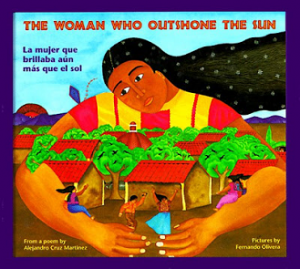Reviewed by Judy Zalazar Drummond
Review Source: De Colores
Book Author: Alejandro Cruz Martinez
In the The Woman Who Outshone the Sun / La mujer que brillaba aún más que el sol, Lucía Zenteno arrives at a village, and because of her great beauty and her magical ways, all the creatures of the earth, air, and water — and the river itself — fall in love with her. The jealous villagers run her out of town, so she takes the river with her, leaving only “a serpent of sand.” The villagers find Lucía, the elders convince them to apologize, and after a few words about the necessity of treating everyone with kindness, she returns the water and disappears again, coming back as a fond memory: “Lucía had not really left them. Though they would not be able to see her, she would always be there, guiding and protecting them, helping them to live with love and understanding in their hearts.”
Oaxacan artist Olivera’s gorgeous oil paintings, saturated in rich, bold colors, are full of “magic realism,” where fishes and otters swim in and out of Lucía’s hair, butterflies fly in and out of her skirts, and her sorrow at the behavior of the villagers is palpable. Olivera’s Zapotecanas are big and beautiful, and his Lucía is lush and glorious — a dark, zaftig Indian woman, with big hips and big feet, a Mother Earth figure.
The book, winner of an Outstanding Children’s Book Award from Parenting Magazine, has garnered numerous positive reviews praising it for its strong moral message about kindness and understanding and respect for nature and responsibility for the earth. Continue reading.

The Woman Who Outshone the Sun by Alejandro Cruz Martinez
Published by Scholastic on January 1, 1991
Genres: Latinx
Pages: 30
Reading Level: Grade K
ISBN: 9780590473040
Review Source: De Colores: The Raza Experience in Books for Children

Leave a Reply